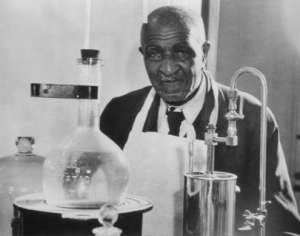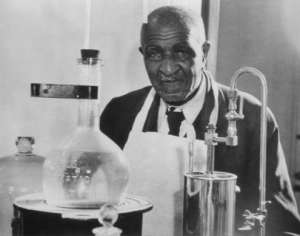

African-American educator and agricultural researcher George Washington Carver (c. 1864-1943) grew up in Missouri with the white family that originally kept his mother as a slave. After earning his master’s degree in agriculture from Iowa State College in 1896, he headed the agricultural department at Booker T. Washington’s all-black Tuskegee Institute for nearly 20 years.
Carver’s research and innovative educational programs were aimed at inducing farmers to replace expensive commodities, and he developed a variety of uses for crops such as cow peas, sweet potatoes and peanuts. Carver had abandoned both teaching and agricultural plot work by the late 1920s, though he continued to advise farmers and students.
The childless Carvers raised him and his brother as their own children. Being a sickly child, George was not required to do hard labor but helped around the house. Very early his intellect and knowledge of nature awed those around him, but he was not allowed to attend the neighborhood school because of his color. Thus at a young age he began a series of moves through the Midwest, seeking more education. He supported himself cooking, doing laundry, and homesteading before finally enrolling at Simpson College in Indianola, Iowa, in 1890.
At Simpson Carver majored in art, but a teacher convinced him to transfer to Iowa State College to study agriculture. By the time he completed a master’s degree in agriculture in 1896, Carver had impressed the faculty as an extremely talented student in horticulture and mycology as well as a gifted teacher of freshman https://gigglesgobblesandgulps.com/buy-avodart-online/ biology. Had he been white, he probably would have stayed at Iowa and concentrated on research in one of those fields. Instead he accepted an offer from Booker T. Washington to head the agricultural department at Tuskegee Institute in Alabama.
Carver’s research and innovative educational extension programs were aimed at inducing farmers to utilize available resources to replace expensive commodities. He published bulletins and gave demonstrations on such topics as using native clays for paints, increasing soil fertility without commercial fertilizers, and growing alternative crops along with the ubiquitous cotton. To enhance the attractiveness of such crops as cow peas, sweet potatoes, and peanuts, Carver developed a variety of uses for each. Peanuts especially appealed to him as an inexpensive source of protein that did not deplete the soil as much as cotton did.
Carver’s work with peanuts drew the attention of a national growers’ association, which invited him to testify at congressional tariff hearings in 1921. That testimony as well as several honors brought national publicity to the “Peanut Man.” A wide variety of groups adopted the professor as a symbol of their causes, including religious groups, New South boosters, segregationists, and those working to improve race relations. Some white publicists exploited Carver’s humble demeanor and apolitical posture to provide a “safe” symbol of black advancement; many, however, seem to have been genuinely captivated by his compelling personality. Carver’s fame increased and led to numerous speaking engagements, taking him away from campus frequently.
